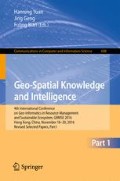Abstract
The sequential pattern data mining technology is widely applied to various fields, and it brings an indispensable value for many areas, especially in the field of medical treatment. But the amount of health-care data is large and the information included is extensive, so some valuable information may have not been found, which needs us to take the further research. By using the Sequential Pattern Mining (SPAM) algorithm to deal with the health-care data, we try to find the user’s medical behavior and the doctor diagnosis model or rule. This article first introduces the characteristics and the worth of Medicare data and data mining on it, especially the sequence pattern mining significance. Then discusses the ideas and characteristics of SPAM algorithm and the advantages of high efficiency, we use SPAM algorithm to deal with health care data, and try to find the regularity of visiting doctor, medical treatment characteristics and drug-use mode about insured person in a certain period of time. The experiments reveal the treatment mode and characteristics of the drug of pregnancy, which can provide guidance and reference for the diagnosis and treatment.
Access this chapter
Tax calculation will be finalised at checkout
Purchases are for personal use only
References
Feng, L.: Review of data mining application in medical insurance in our country. Comput. Knowl. Technol. 21, 880–882 (2014)
Du, Y.: Studying on the design of overall basic medical insurance system. Chin. Health Serv. Manag. 32, 90–92 (2015)
Zhao, Y.: Mechanism of prepaid method of medical insurance in controlling medical expense. Chin. Hosp. Manag. 35, 45–47 (2015)
Lei, Y., Li, M., Hu, W., Song, G.: Efficient methods for rare sequential pattern mining. J. Frontiers Comput. Sci. Technol. 9, 429–437 (2015)
Xu, Y.: Data preparation for risk control of medical insurance fund. Fudan University, Jilin (2010)
Liu, S., Yang, H.: Study on medical insurance fraud detection system based on multi-agent. Comput. Technol. Dev. 23, 171–174 (2013)
Qu, G., Cui, S., Tang, J.: Active and passive factors analysis of the medical insurance fund expenditure–taking Dalian as an example. vol. 19, pp. 120–125 (2014)
Agrawal, R., Srikant, R.: Mining sequential patterns. In: Proceedings of the 11th International Conference on Data Engineering. IEEE Computer Society, Los Alamitos (1995)
Tao, H., Jiang, F.: Application of improved sequential pattern mining in hospital referral. Comput. Syst. Appl. 10, 253–258 (2015)
Xu, T.T., Dong, X.J.: E-MsNFIS: efficient negative frequent itemsets mining based on multiple minimum supports. Appl. Mech. Mater. 411–414, 386–389 (2013)
Cao, L., Dong, X., Zheng, Z.: e-NSP: efficient negative sequential pattern mining. Artif. Intell. 235, 156–182 (2016)
Xiangjun, D.: Mining infrequent itemsets based on extended MMS Model. Commun. Comput. Inf. Sci. 2, 190–198 (2007)
Imran, M.: Authentication user’s privacy: an integrating location privacy protection algorithm for secure moving objects in location based services. Wirel. Pers. Commun. 82, 1585–1600 (2015)
Memon, I., Chen, L., Majid, A., Lv, M., Hussain, I., Chen, G.: Travel recommendation using geo-tagged photos in social media for tourist. Wirel. Pers. Commun. 80, 1347–1362 (2015)
Srikant, R., Agrawal, R.: Mining sequential patterns: generalizations and performance improvements. In: Proceedings of the 5th International Conference Extending Database Technology, EDBT 1996, London, UK (1996)
Cheng, S., Ma, C., Li, C.: High utility sequential pattern mining algorithm based on MapReduce. Comput. Syst. Appl. 12, 228–232 (2015)
Ayres, J., Flannick, J., Gehrke, J., Yiu, T.: Sequential pattern mining using a bitmap representation. In: Proceeding of the 8th ACM SIGKDD International Conference on Knowledge Discovery and Data Mining, KDD 2002, New York, USA, pp. 429–435 (2002)
Chen, J., Weng, Z.: An algorithm of SPAM based on projected database. Comput. Knowl. Technol. 6, 1537–1539 (2010)
Zhang, W., Liu, F., Teng, S.: Improved PrefixSpan algorithm and its application in sequential pattern mining. J. Guangdong Univ. Technol. 30, 49–54 (2013)
Acknowledgments
This work was supported partly by the Jinan youth science and technology star plan (No. 20120104), National Natural Science Foundation of China (71271125) and Scientific Research Development Plan Project of Shandong Provincial Education Department (J12LN10).
Author information
Authors and Affiliations
Corresponding author
Editor information
Editors and Affiliations
Rights and permissions
Copyright information
© 2017 Springer Nature Singapore Pte Ltd.
About this paper
Cite this paper
Cheng, Q., Ren, X. (2017). Medical Insurance Data Mining Using SPAM Algorithm. In: Yuan, H., Geng, J., Bian, F. (eds) Geo-Spatial Knowledge and Intelligence. GRMSE 2016. Communications in Computer and Information Science, vol 698. Springer, Singapore. https://doi.org/10.1007/978-981-10-3966-9_11
Download citation
DOI: https://doi.org/10.1007/978-981-10-3966-9_11
Published:
Publisher Name: Springer, Singapore
Print ISBN: 978-981-10-3965-2
Online ISBN: 978-981-10-3966-9
eBook Packages: Computer ScienceComputer Science (R0)

